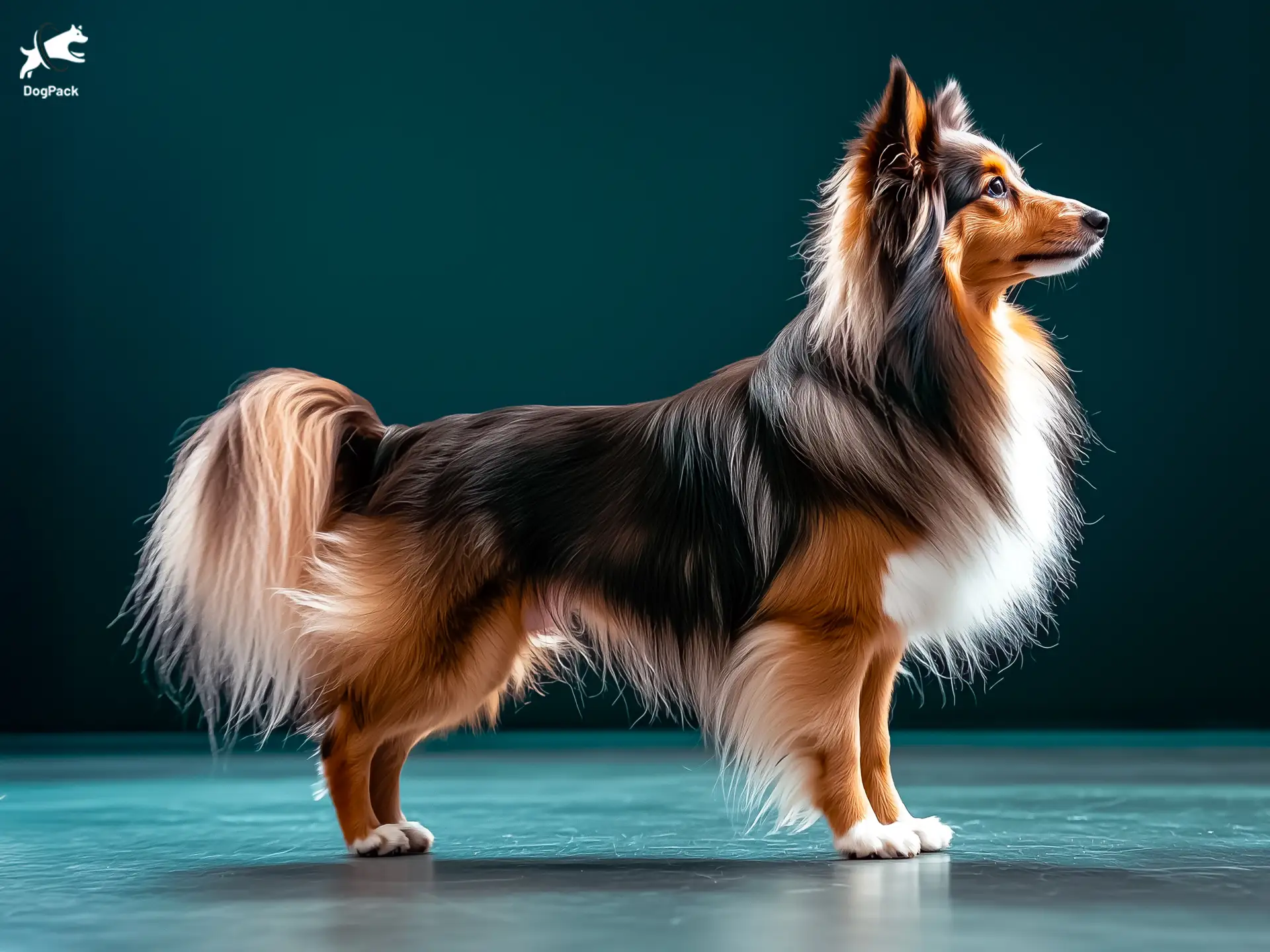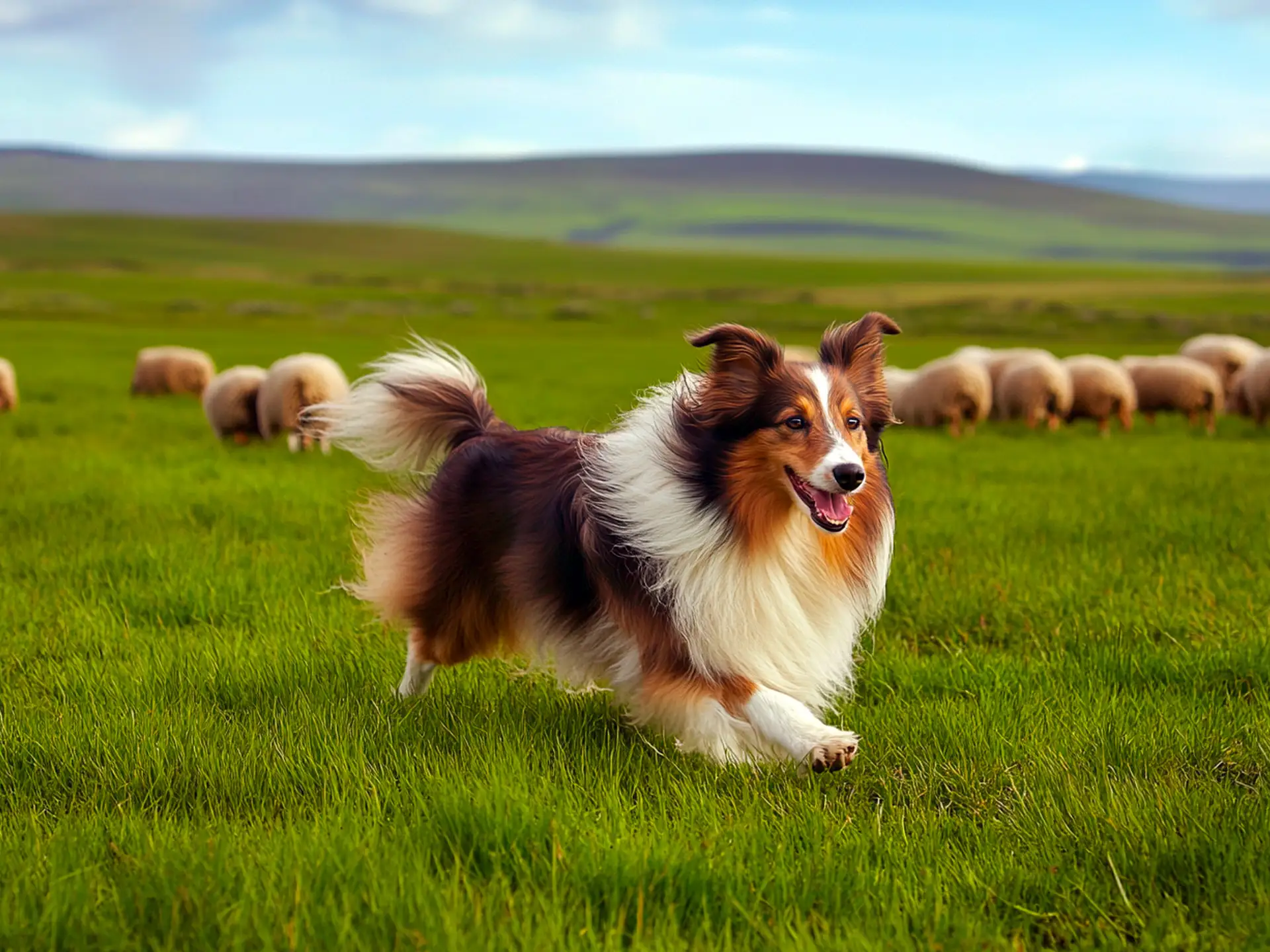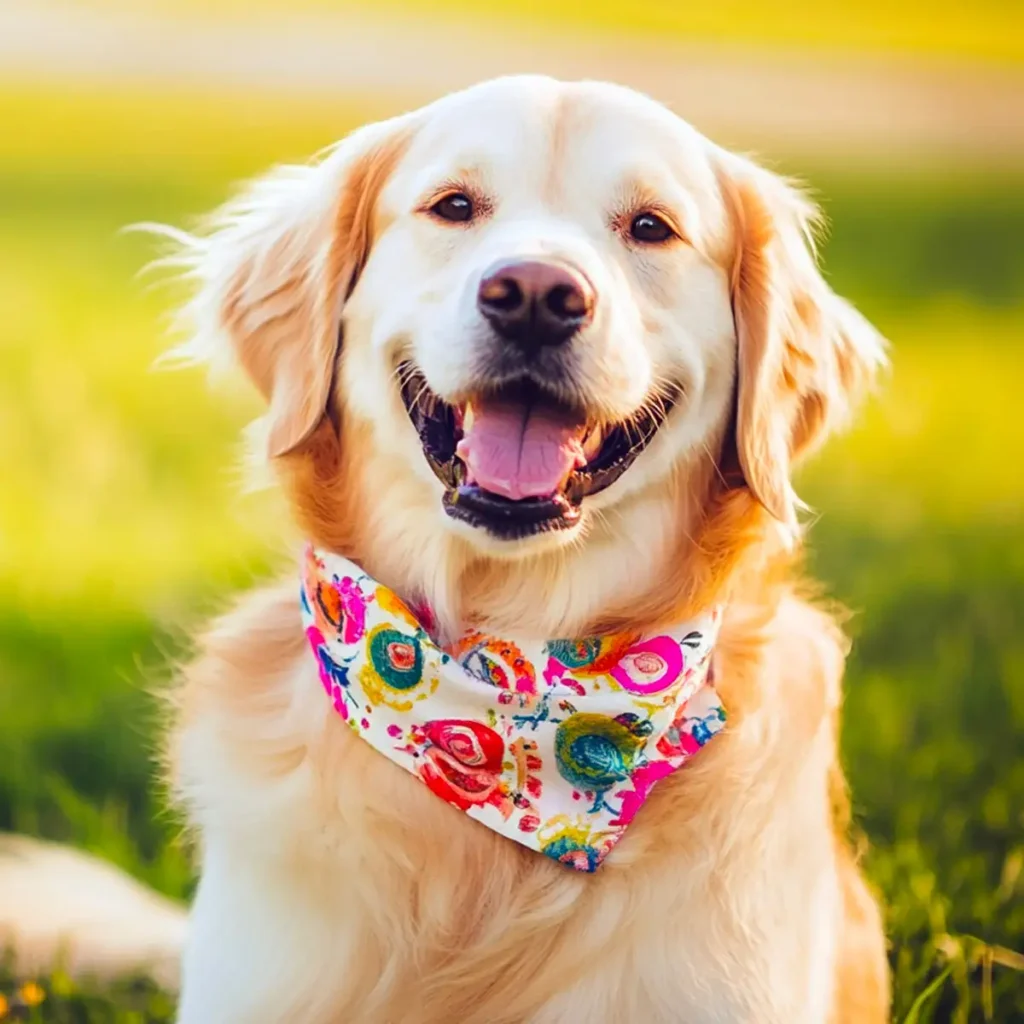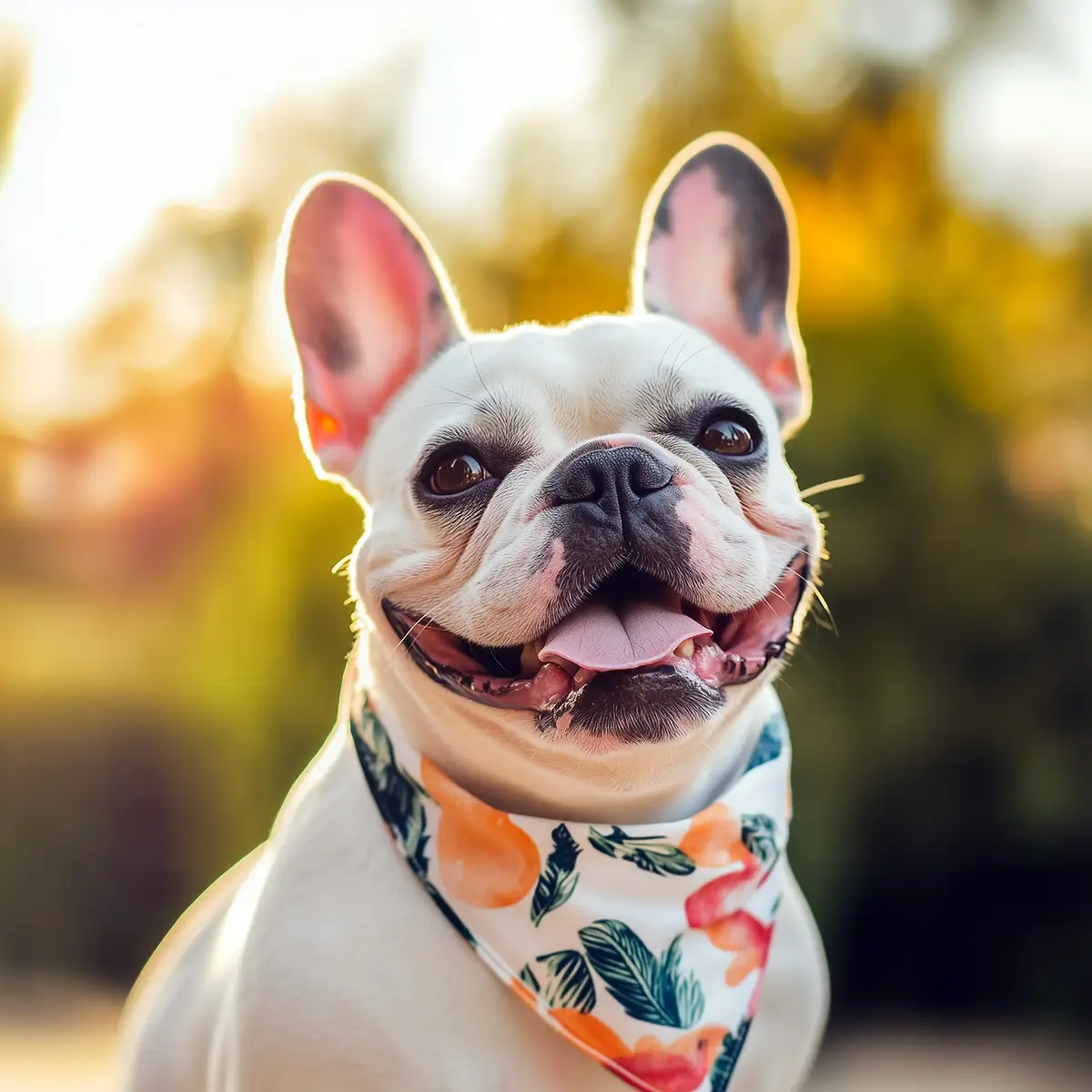Shetland Sheepdog Dog Breed Info & Overview
The Shetland Sheepdog, hailing from the rugged Shetland Islands, is a clever and affectionate breed wrapped in a luxuriously fluffy coat. Renowned for their intelligence and gentle nature, these agile dogs make devoted companions for active families. Beneath their elegant appearance lies a hardworking herder with a big heart—always eager to learn, please, and bring joy to those around them.
Characteristics
Pictures
Breed History
The Shetland Sheepdog originated in the remote, windswept Shetland Islands north of mainland Scotland. Centuries ago, farmers needed a capable herder that could manage smaller livestock, like the region’s miniature sheep. Through selective breeding, locals refined a pint-sized herding marvel. Though they share some ancestry with the Rough Collie, the Sheltie is entirely its own breed, prized for agility and a watchful nature.
By the early 20th century, visitors to the Shetland Islands started bringing these dogs back home, smitten by their plucky spirit. Scottish and English dog enthusiasts played a key role in standardizing the breed. Over time, the Sheltie’s combination of intelligence, loyalty, and manageable size led to a growing international fan base. Today, they remain a favorite for herding trials and family life alike.
Originally called the “Shetland Collie,” they were eventually recognized by kennel clubs as the Shetland Sheepdog. Dedicated groups, including the American Kennel Club, officially recognized them in the early 1900s. Despite modernization, the breed’s herding instincts remain strong, and many Shelties still excel at farm work. Their storied history is a testament to their adaptability and unwavering devotion.
Temperament, Personality
If you’re looking for a spirited sidekick with a gentle heart, you’ll find it here. These dogs thrive on human interaction, forming close bonds with their families. They’re often called “Velcro dogs” because they love to stick by your side. Yet, they’re not needy—just tuned in to your emotions and eager to please, making them great for those who enjoy quality time with their pets.
While they are affectionate, Shelties can be a bit reserved around strangers. Early socialization works wonders, helping them gain confidence in meeting new people. Their sensitive nature also means they respond best to calm, encouraging training methods—shouting or harsh discipline can rattle them. They thrive in a friendly, upbeat household where treats, praise, and the occasional squeaky toy keep them motivated.
Families with children often adore these pint-sized herders for their patience and playful energy. They’re quick to chase after a tossed ball or join a game of tag in the backyard. Still, it’s wise to supervise interactions with very young kids, as Shelties may try to “herd” them by nipping heels (a leftover from their working roots). Overall, they’re gentle souls that fit well into many family dynamics.
Physical Characteristics
Don’t let their fluffy exterior fool you—these little dynamos are sturdier than they look. Standing between 13–16 inches at the shoulder, they’re typically well-proportioned, with a refined head and alert, wedge-shaped muzzle. Perky, partially tipped ears give them a permanently curious expression, especially when they tilt their head at something interesting you say (or maybe just the crinkle of a treat bag).
A hallmark of the Shetland Sheepdog is its luxurious double coat. The outer layer is straight and harsh to the touch, providing a weather-resistant shield, while the undercoat is dense and soft for warmth. Classic coat colors include sable (brownish-gold), black, and blue merle, often with striking white markings. When they sprint across a yard, their coat flows behind them like a superhero’s cape.
Shelties carry themselves with elegance—there’s a light, sprightly gait in every step. Though small, they’re muscular enough to handle agility courses and herding trials. That slender silhouette and bushy tail can mislead folks into thinking these dogs are dainty lapdogs. In reality, they’re nimble athletes ready to zip around the yard at a moment’s notice, especially when there’s a squeaky toy in sight.
Health Issues
Like many purebred dogs, Shelties can be prone to certain genetic conditions. One issue to watch for is Collie Eye Anomaly (CEA), a hereditary disorder affecting eye development. Regular veterinary eye exams can catch this early. Also, hip dysplasia can occur, though it’s less common in this smaller breed compared to larger herders. Staying aware of your dog’s mobility helps detect problems promptly.
Another consideration is hypothyroidism, where the thyroid gland underperforms and slows metabolism. Symptoms include weight gain and low energy. Medication typically manages it well, but early diagnosis is crucial. Dental health is also important; Shelties’ smaller jaws can lead to crowding, so routine check-ups and brushing are helpful. An ounce of prevention truly is worth a pound of cure with these active canines.
Regular check-ups, ideally twice a year, help ensure your Sheltie’s continued good health. Screenings for eye and thyroid issues, plus hip evaluations, are recommended if you’re planning to breed. Try to maintain a good exercise regimen and balanced diet to prevent obesity—extra pounds can exacerbate joint stress. By staying attentive and partnering with your veterinarian, you can keep your furry friend thriving for many happy years.
Grooming Needs
The Shetland Sheepdog’s coat may look like a full-time chore, but it doesn’t have to be daunting. A thorough brushing two to three times a week removes tangles and reduces matting—particularly around the ears, armpits, and fluffy rear end. Shelties have a noticeable “ruff” of fur around their neck, which should also get special attention to keep it looking plush and tidy.
Because they have that thick double coat, seasonal shedding—often called “blowing coat”—can get intense. During these times, daily brushing helps manage fur tumbleweeds rolling through your home. A pin brush, slicker brush, and a good comb will be your best friends. Light trimming around the feet or sanitary areas is usually enough, but professional grooming every few months can keep them looking especially polished.
Over-bathing can strip the coat’s natural oils, so a bath every six to eight weeks typically suffices unless your dog finds a mud puddle. Pay attention to their nails, too. Shelties are active, but they may still need a monthly nail trim. Ears should be checked weekly for debris, and teeth need regular brushing or dental chews. With consistent care, that glorious coat will remain soft and lustrous.
Exercise Requirements
Bred to herd and alert farmers on the rugged Shetland Islands, these dogs are full of pep. They generally need at least an hour of physical activity daily. A brisk morning walk plus some backyard fetch is a great start. Mental stimulation is equally important—try puzzle toys, hide-and-seek games, or short agility sessions to keep them entertained and out of mischief.
Shelties excel in dog sports like agility, obedience, and even rally events. They love tasks that challenge their mind and body. A bored Sheltie might fill their day with barking or obsessive behaviors, so it’s wise to channel that energy productively. If you’ve got a fenced yard, watch how they joyfully sprint in circles, tail waving like a banner.
Structured daily walks are important, but remember they’re not the only way to exercise. These dogs adore short bursts of intense play—think chase games or practicing new tricks. After a solid workout, they’re more than happy to sprawl on the couch for a nap, recharging for the next adventure. Keep them busy, and your Shetland Sheepdog will reward you with unwavering devotion and fewer restless antics.
Training Tips
Positive reinforcement is the secret sauce. A Sheltie’s sensitive nature means they respond best to praise, treats, and gentle encouragement. Start obedience training early, because these bright pups love structured learning. They pick up commands quickly, but they can also outsmart you if bored. Aim for short, varied sessions that keep things fun. Consistency and plenty of praise go a long way with these bright sparks.
Focus on socializing your dog from puppyhood. Expose them to different people, environments, and other small dog breeds so they develop into a well-adjusted companion. Shelties do have a tendency to bark—sometimes excitedly, sometimes out of caution—so teaching a “quiet” command early can be a lifesaver. Patience and kindness will shape them into polite family members ready for all sorts of adventures.
Trick training can also be a blast with these dogs. They love tasks that let them show off, like weaving through your legs or fetching specific items. Because they read human cues so closely, they often anticipate your next move—so vary your routines to keep them on their toes. If they get something wrong, avoid scolding; a gentle redirection is much more effective for a Shetland Sheepdog.
Nutrition, Diet
A Shetland Sheepdog’s fast metabolism, paired with high energy, calls for a diet rich in animal-based proteins such as chicken, salmon, or turkey. Aim for premium-quality kibble or a carefully balanced fresh-food plan. Because they can be prone to weight gain, especially as they age, watch portion sizes and incorporate low-fat treats like carrot slices for rewards.
On average, adult Shelties weighing around 20 pounds may eat roughly 1 to 1.25 cups of kibble per day, split into two meals. Highly active individuals—those participating in agility or herding—might need slightly more, while less active ones could require less. Keep an eye on body condition rather than relying on the bowl alone. An easy waistline check can guide if you need to adjust portions.
Choose formulas specifically designed for small, active breeds. Omega-3 fatty acids help maintain their lush coat and support joint health. Avoid fillers like excessive corn or wheat that can cause digestive issues. Always consult with a vet or a canine nutritionist before making drastic changes. Because Shelties can be sensitive to certain ingredients, introduce new foods gradually, and monitor for any signs of stomach upset or allergies.
Adoption, Breeders
When looking for a Shetland Sheepdog, prioritize reputable breeders who perform health screenings for common issues like Collie Eye Anomaly or hip dysplasia. A trustworthy breeder will be transparent, allowing you to meet the puppy’s parents and providing detailed medical records. Expect a waiting list for well-bred puppies—the best breeders focus on health and temperament, not just quick turnover.
If adoption appeals to you, check breed-specific rescues that specialize in Shelties. Organizations like the American Shetland Sheepdog Association can guide you toward rescue resources. Shelters occasionally have Shelties or mixed Shelties looking for a second chance. Meeting the dog and understanding its background can help ensure a good match, especially if you have children or other pets at home.
AKC Marketplace is another place to find breeders committed to health and breed standards. Before bringing a Sheltie home, ask questions about socialization, diet, and any inherited health conditions. A little research goes a long way in welcoming a happy, thriving companion into your life. Whether you adopt or purchase, keep an open mind—these bright, loyal dogs can make wonderful matches for dedicated owners.
Family Pet?
This breed can be a dream for families who appreciate a lively, watchful dog. They’re eager participants in backyard games, quick to learn household rules, and equally content to snooze at your feet after playtime. Because they’re small, they fit comfortably in many home environments, from country houses to cozier setups, as long as they get daily mental and physical engagement.
Shelties generally do well with children, especially if raised alongside them. They’re patient and gentle, though they might instinctively attempt to herd little ones by nudging or nipping. Consistent training and supervising play sessions help channel these instincts appropriately. Many families relish the dog’s eagerness to be involved in every activity, from chasing bubbles on a summer day to snuggling for a family movie night.
When it comes to other pets, Shelties can be surprisingly adaptable. With proper introductions, they may coexist peacefully with cats and even get along with larger dogs, though they’ll likely try to organize everyone into neat little groups—herding is in their DNA, after all. Ultimately, the Shetland Sheepdog is a dedicated companion that thrives in a family setting bursting with attention and affection.
Right For You?
Anyone seeking an enthusiastic partner for outdoor adventures, who also doesn’t mind a bit of barking or a fluff-covered sofa, will love this breed. They excel in homes that can provide mental stimulation—so if you’re up for puzzle toys and daily walks, you’re on the right track. They appreciate structure and can be reserved if under-socialized, so your commitment to training is crucial.
They’re smaller than many herding breeds, making them suitable for those with limited space, but not limited free time. If you’re often away, a Sheltie could become anxious or vocal. A consistent routine, interactive play sessions, and gentle handling are must-haves. They’ll return the favor with unwavering loyalty and comedic moments—like a dog that tries to herd the vacuum cleaner into a corner.
If you adore dogs with a keen mind and a sense of duty, this breed might be your perfect match. However, if you dislike brushing or prefer a silent companion, the Sheltie’s grooming and vocal tendencies may not be ideal. Consider your own activity level and desire for a shadow-like friend. Their big personality and affectionate nature shine brightest when they’re part of an engaged, caring home.
Conclusion
Bright, eager, and wrapped in a soft, plumed coat, the Shetland Sheepdog brings fun and loyalty to any household ready for their zest. Socializing them early and offering daily exercise fosters a balanced, happy companion. If you enjoy a dog that learns tricks rapidly, adores active play, and loves family time, a Sheltie might just become your favorite housemate—four paws and all.
FAQs
-
Why do some Shetland Sheepdogs have blue eyes?
Some Shetland Sheepdogs, particularly merle-coated ones, may inherit blue eyes due to a genetic trait associated with the merle gene. This is completely normal and does not affect their vision, though double merle breeding can increase the risk of eye abnormalities.
-
Do Shetland Sheepdogs instinctively try to herd their owners?
Yes! Shetland Sheepdogs retain strong herding instincts and may try to herd small children, other pets, or even their owners by circling or gently nudging. Early training can help redirect this behavior into positive activities like agility or obedience work.
-
Why do Shetland Sheepdogs often “talk” or make different vocal sounds?
Shetland Sheepdogs are known for their expressive vocalizations, which can range from barking to “talking” sounds. This trait stems from their past as alert watchdogs for farms, where they needed to communicate frequently with their owners.
-
Do Shetland Sheepdogs have a strong sense of smell compared to other breeds?
While not traditionally scent-focused like hounds, Shetland Sheepdogs have a highly developed sense of smell, which makes them excellent at tracking, search-and-rescue training, and even canine scent work sports.
-
What historical role did Shetland Sheepdogs play besides herding?
Beyond herding, Shetland Sheepdogs were also used as farm guardians, protecting poultry and livestock from birds of prey and small predators. Their keen eyesight and sharp instincts made them versatile farm dogs in the Shetland Islands.
Breed Ratings
The Shetland Sheepdog ranks among the smartest canines, picking up new commands with lightning speed.
Always up for a friendly chase or puzzle game, they’re eager to engage in various activities.
While smaller than other herding dogs, they still have plenty of pep to keep them on the move.
Their luxurious double coat sheds heavily, especially during seasonal molts—expect extra vacuuming.
Moderate prey drive can surface, but they mostly focus on herding rather than chasing small animals.
Regular brushing is necessary; the thick undercoat can mat if neglected.
Quick learners with a strong desire to please, they excel in obedience with positive reinforcement.
They’re social creatures that can become anxious or vocal if left too often.
Shelties are watchful and vocal, but can be trained to moderate their barking.
Drooling is minimal, so you won’t need to keep a towel handy.
Generally sociable, they can blend well with other dogs if introduced early.
Overall robust, but watch for specific genetic issues like eye and thyroid concerns.















